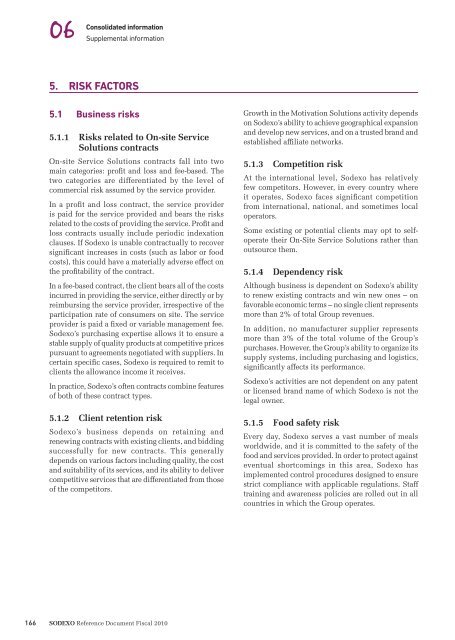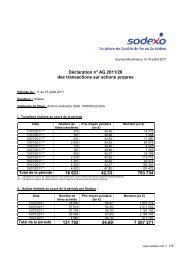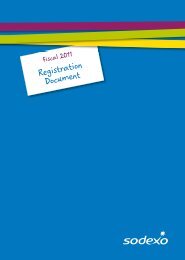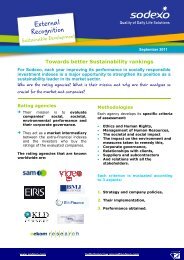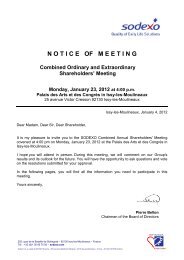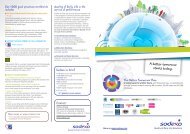5. RISK FACTORS
5. RISK FACTORS
5. RISK FACTORS
You also want an ePaper? Increase the reach of your titles
YUMPU automatically turns print PDFs into web optimized ePapers that Google loves.
166<br />
06<br />
Consolidated information<br />
Supplemental information<br />
<strong>5.</strong> <strong>RISK</strong> <strong>FACTORS</strong><br />
<strong>5.</strong>1 Business risks<br />
<strong>5.</strong>1.1 Risks related to On-site Service<br />
Solutions contracts<br />
On-site Service Solutions contracts fall into two<br />
main categories: profi t and loss and fee-based. The<br />
two categories are differentiated by the level of<br />
commercial risk assumed by the service provider.<br />
In a profi t and loss contract, the service provider<br />
is paid for the service provided and bears the risks<br />
related to the costs of providing the service. Profi t and<br />
loss contracts usually include periodic indexation<br />
clauses. If Sodexo is unable contractually to recover<br />
signifi cant increases in costs (such as labor or food<br />
costs), this could have a materially adverse effect on<br />
the profi tability of the contract.<br />
In a fee-based contract, the client bears all of the costs<br />
incurred in providing the service, either directly or by<br />
reimbursing the service provider, irrespective of the<br />
participation rate of consumers on site. The service<br />
provider is paid a fi xed or variable management fee.<br />
Sodexo’s purchasing expertise allows it to ensure a<br />
stable supply of quality products at competitive prices<br />
pursuant to agreements negotiated with suppliers. In<br />
certain specifi c cases, Sodexo is required to remit to<br />
clients the allowance income it receives.<br />
In practice, Sodexo’s often contracts combine features<br />
of both of these contract types.<br />
<strong>5.</strong>1.2 Client retention risk<br />
Sodexo’s business depends on retaining and<br />
renewing contracts with existing clients, and bidding<br />
successfully for new contracts. This generally<br />
depends on various factors including quality, the cost<br />
and suitability of its services, and its ability to deliver<br />
competitive services that are differentiated from those<br />
of the competitors.<br />
SODEXO Reference Document Fiscal 2010<br />
Growth in the Motivation Solutions activity depends<br />
on Sodexo’s ability to achieve geographical expansion<br />
and develop new services, and on a trusted brand and<br />
established affi liate networks.<br />
<strong>5.</strong>1.3 Competition risk<br />
At the international level, Sodexo has relatively<br />
few competitors. However, in every country where<br />
it operates, Sodexo faces signifi cant competition<br />
from international, national, and sometimes local<br />
operators.<br />
Some existing or potential clients may opt to selfoperate<br />
their On-Site Service Solutions rather than<br />
outsource them.<br />
<strong>5.</strong>1.4 Dependency risk<br />
Although business is dependent on Sodexo’s ability<br />
to renew existing contracts and win new ones – on<br />
favorable economic terms – no single client represents<br />
more than 2% of total Group revenues.<br />
In addition, no manufacturer supplier represents<br />
more than 3% of the total volume of the Group’s<br />
purchases. However, the Group’s ability to organize its<br />
supply systems, including purchasing and logistics,<br />
signifi cantly affects its performance.<br />
Sodexo’s activities are not dependent on any patent<br />
or licensed brand name of which Sodexo is not the<br />
legal owner.<br />
<strong>5.</strong>1.5 Food safety risk<br />
Every day, Sodexo serves a vast number of meals<br />
worldwide, and it is committed to the safety of the<br />
food and services provided. In order to protect against<br />
eventual shortcomings in this area, Sodexo has<br />
implemented control procedures designed to ensure<br />
strict compliance with applicable regulations. Staff<br />
training and awareness policies are rolled out in all<br />
countries in which the Group operates.
However, if Sodexo were to incur signifi cant liability<br />
at one or more of its sites, this would impact its<br />
activities, operating margins and reputation.<br />
<strong>5.</strong>1.6 Risks related to food cost infl ation,<br />
increases in indirect costs related<br />
to operational activities, and<br />
access to food commodities<br />
Sodexo could be exposed to fl uctuations in food prices<br />
and diffi culties in the supply of certain products. The<br />
price of food and its availability in the marketplace<br />
may vary in different regions of the world.<br />
Sodexo contracts include certain clauses allowing for<br />
increases in prices or menu changes, but given the<br />
delays in implementing such measures, a temporary<br />
reduction in margins cannot be ruled out. Although<br />
most contracts include a minimum increase in the<br />
pricing of products and services provided by the<br />
Group, Sodexo could be affected during infl ationary<br />
periods if the contracted increase rate is lower than<br />
the infl ation rate.<br />
<strong>5.</strong>1.7 Facilities Management risk<br />
Although Facilities Management services have long<br />
been a part of the business, Sodexo’s strategy is to<br />
accelerate the development of Facilities Management<br />
services, resulting in a larger contribution to revenue.<br />
These services require skilled personnel, particularly<br />
in the areas of building maintenance, electrical<br />
engineering, plumbing, heating and cooling systems.<br />
Therefore, the Group faces certain operational risks<br />
and has a need for qualifi ed human resources. The<br />
Group’s knowledge of these markets and its ability to<br />
fi nd, attract, recruit and train employees will allow<br />
it to grow in this highly specialized environment.<br />
<strong>5.</strong>2 Employment risk<br />
Service quality is largely dependent on the ability to<br />
attract, develop, motivate and retain the best talent,<br />
and to provide a suffi cient level of training in order<br />
Consolidated information 06<br />
Supplemental information<br />
to constantly raise standards. For these purposes,<br />
Sodexo has developed training policies at every<br />
level of the organization, with a particular focus on<br />
prevention and safety.<br />
The diversity of backgrounds, cultures and skills<br />
among its people represents both a challenge and an<br />
opportunity. Sodexo is committed to capitalizing on<br />
this diversity to gain a competitive edge and become<br />
a genuine worldwide player, so that its people – at<br />
every level – refl ect the diversity of the Group’s clients<br />
and customers.<br />
Since late 2009, Sodexo has been the target of a<br />
campaign, in the United States and elsewhere, waged<br />
by an American labor union seeking to harm the<br />
Group’s image with clients, consumers, shareholders<br />
and public authorities. Apart from this campaign,<br />
as far as it is aware Sodexo is not exposed to any<br />
specifi c labor-related risk other than those that arise<br />
in the ordinary course of business for a worldwide<br />
group of its size.<br />
<strong>5.</strong>3 Environmental risk<br />
Sodexo is aware of the potential environmental<br />
impact of its activities, even though it operates<br />
on its clients’ sites. Rather than underestimate its<br />
importance, the Group makes every effort to manage<br />
and limit environmental risk.<br />
The environmental impact of its activities arises<br />
mainly from:<br />
• consumption of water and energy in foodservices<br />
facilities, food preparation and cleaning;<br />
• production of waste from food preparation and<br />
cleaning (packaging, organic matter, waste fats and<br />
oils, and waste water from cleaning).<br />
As part of its role as a corporate citizen, in 2009<br />
Sodexo launched The Better Tomorrow Plan, an<br />
iterative and continuous improvement program.<br />
This plan identifi es 14 commitments pertaining to<br />
nutrition, health and wellness, local communities,<br />
and the environment.<br />
SODEXO Reference Document Fiscal 2010<br />
167
168<br />
06<br />
Consolidated information<br />
Supplemental information<br />
<strong>5.</strong>4 Regulatory risk<br />
The nature of Sodexo’s business and its worldwide<br />
presence mean that it is subject to a wide variety<br />
of laws and regulations including labor law,<br />
antitrust law, corporate law, and health, safety and<br />
environmental law.<br />
Sodexo has the legal structures in place at the<br />
appropriate levels to ensure compliance with these<br />
laws and regulations.<br />
Changes in laws or regulations could have a direct<br />
impact on the business and/or the services provided.<br />
For example, the Motivation Solutions activity is<br />
subject to national tax and labor law provisions.<br />
Signifi cant changes in these provisions as they relate<br />
to the issuance of service vouchers could open up<br />
opportunities for new contracts or jeopardize existing<br />
ones.<br />
<strong>5.</strong>5 Interest rate, liquidity, foreign<br />
exchange and counter-party risk<br />
Sodexo has access to a wide variety of bank funding<br />
sources in addition to raising funds directly from<br />
investors on the commercial paper and bond<br />
markets. Because it has operations in 80 countries, all<br />
components of the fi nancial statements are inevitably<br />
infl uenced by foreign currency translation effects,<br />
and in particular by fl uctuations in the US dollar, the<br />
UK pound sterling, the Swedish crown, the Brazilian<br />
real, and the Venezuelan bolivar. However, exchange<br />
rate fl uctuations do not generate operational risk,<br />
because each subsidiary bills its revenues and incurs<br />
its expenses in the same currency.<br />
Sodexo uses derivative instruments to manage its<br />
exposure to interest rate and foreign exchange risk.<br />
Additional information relating to these risks is found<br />
in notes <strong>5.</strong>1, <strong>5.</strong>2 and <strong>5.</strong>3 to the consolidated fi nancial<br />
statements.<br />
<strong>5.</strong>6 Economic downturn risk<br />
Adverse economic conditions could affect the Group’s<br />
operations and earnings.<br />
SODEXO Reference Document Fiscal 2010<br />
The diffi cult economic climate could depress demand<br />
for the services Sodexo offers its clients, in particular<br />
in the Corporate segment, with negative consequences<br />
for earnings. In addition, public sector clients could<br />
be confronted with budget constraints. Nonetheless,<br />
Sodexo’s clients (accounting for around two-thirds of<br />
annual revenues) are predominantly in less cyclical<br />
sectors such as Education, Healthcare, Justice and<br />
Defense. In addition, the economic situation could<br />
lead clients to increase outsourcing in order to<br />
achieve cost savings. The Remote sites activity is<br />
dependent on the petroleum and mining industries.<br />
Lastly, adverse economic conditions could impair the<br />
solvency of Sodexo’s clients.<br />
<strong>5.</strong>7 Acquisition risk<br />
Sodexo has acquired and may in the future acquire<br />
businesses. Acquisitions enhance earnings only<br />
if Sodexo can successfully integrate the acquired<br />
businesses into its management organization,<br />
purchasing operations, distribution network and<br />
information systems. The Group’s ability to integrate<br />
acquired businesses may be adversely affected by<br />
factors that include failure to retain management and<br />
sales personnel, the size of the acquired business<br />
and the allocation of limited management resources<br />
among various integration efforts. In addition, the<br />
benefi ts of synergies expected at the time of selecting<br />
acquisition candidates may not be as signifi cant as<br />
originally anticipated. Difficulties in integrating<br />
acquired businesses, as well as liabilities or adverse<br />
operating issues relating to acquired businesses,<br />
could have a material adverse effect on our business,<br />
operating results and fi nancial condition.<br />
<strong>5.</strong>8 Litigation risk<br />
Refer to note 4.28 of the notes to the consolidated<br />
fi nancial statements for information on these risks.


